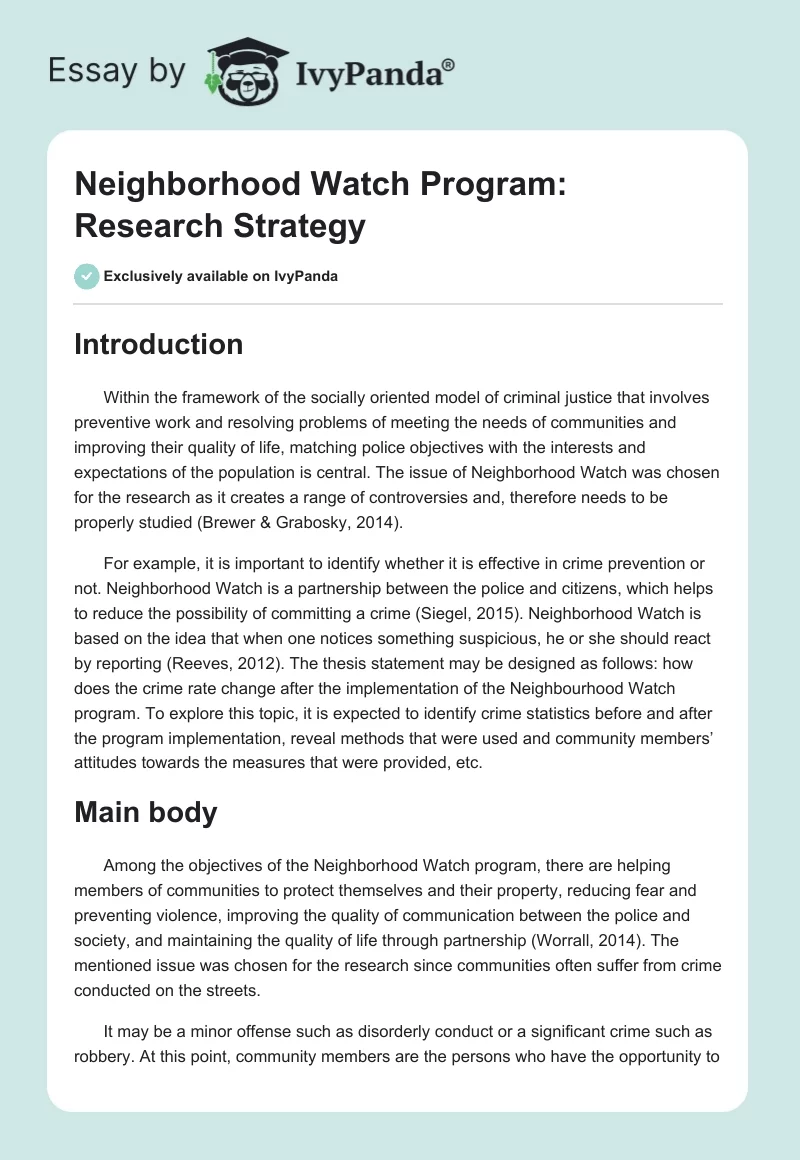Introduction
Within the framework of the socially oriented model of criminal justice that involves preventive work and resolving problems of meeting the needs of communities and improving their quality of life, matching police objectives with the interests and expectations of the population is central. The issue of Neighborhood Watch was chosen for the research as it creates a range of controversies and, therefore needs to be properly studied (Brewer & Grabosky, 2014).
For example, it is important to identify whether it is effective in crime prevention or not. Neighborhood Watch is a partnership between the police and citizens, which helps to reduce the possibility of committing a crime (Siegel, 2015). Neighborhood Watch is based on the idea that when one notices something suspicious, he or she should react by reporting (Reeves, 2012). The thesis statement may be designed as follows: how does the crime rate change after the implementation of the Neighbourhood Watch program. To explore this topic, it is expected to identify crime statistics before and after the program implementation, reveal methods that were used and community members’ attitudes towards the measures that were provided, etc.
Main body
Among the objectives of the Neighborhood Watch program, there are helping members of communities to protect themselves and their property, reducing fear and preventing violence, improving the quality of communication between the police and society, and maintaining the quality of life through partnership (Worrall, 2014). The mentioned issue was chosen for the research since communities often suffer from crime conducted on the streets.
It may be a minor offense such as disorderly conduct or a significant crime such as robbery. At this point, community members are the persons who have the opportunity to contribute to crime prevention by reporting suspicious situations. In future research, it is expected to focus on various methods used by the program and their perceived effectiveness. Currently, the program of Neighborhood Watch is conducted in three directions that are to be investigated:
- uniting groups or communities of citizens residing in a certain area to monitor suspicious persons and inform the police about it;
- marking the property by putting a special number (for example, the postal code of the house and apartment or the owner’s initials) to facilitate the detection of property. Police officers issue stickers for windows warning criminals that the property in the house is under protection;
- organizing visits by police officers to homeowners and residents of the area and the provision of advice in securing the protection of their houses.
The participation in Neighborhood Watch program requires the desire to contribute to the creation of safer living conditions. The main activity of the so-called “neighbors” is to bring any information of a criminal nature to the attention of the police. Sometimes this activity involves the creation of civilian guards for patrolling the territory. Today in the US, there are more than 100 thousand such organizations (“National Neighborhood Watch”, 2017).
The program aims at developing an alarm system based on the interaction between citizens, authorities, and police and raising the level of consciousness of local and regional authorities, police, and citizens regarding the need to improve the crime prevention system. As emphasized by Kang (2015), the program can be effective only with the active participation of all members of society. The first condition is the desire to create the local Neighborhood Watch, while another way to develop citizens’ interest in the program is to participate in meetings of the society to discuss security issues. It should also be noted that another aspect to be studied refers to ethics. In particular, some people believe that it is rather unethical to report about neighbors and their activities as a result of the so-called “spying”, while others consider it appropriate.
Conclusion
Thus, the research will focus on the role of reporting suspicious situations in crime prevention and reduction. The mixed-method design will be applied to reveal the topic. For example, it would be better if the number of crimes was accompanied by an explanation of the situation. Accordingly, the researcher will provide quantitative research finding out the number of crimes and people committed them in different living or social conditions (for example, low-income or high-income), of diverse age of criminals (for instance, adolescent, adults, and elderly), and according to recidivism (whether it is criminal’s first offense or the repeated one).
The qualitative data will also be based on a thorough literature review. To collect the necessary data, a range of scholarly sources will be used, including books, recent peer-reviewed journal articles, and official websites.
The latter is especially important to identify the relevant quantitative data regarding certain communities and create the overall awareness of the existing situation. It is expected then that scholarly articles will provide essential grounds to identify tendencies, advantages, and gaps that the current system involves. Based on the mentioned information, the researcher will understand the issue in an in-depth manner and either support or reject the thesis statement. Moreover, it is expected to point out some recommendations on addressing the challenges and maintaining the effectiveness of the program.
References
Brewer, R., & Grabosky, P. (2014). The unraveling of public security in the United States: The dark side of police-community co-production. American Journal of Criminal Justice, 39(1), 139-154.
Kang, J. H. (2015). Participation in the community social control, the neighborhood watch groups: Individual-and neighborhood-related factors. Crime & Delinquency, 61(2), 188-212.
National Neighborhood Watch. (2017). Web.
Reeves, J. (2012). If you see something, say something: Lateral surveillance and the uses of responsibility. Surveillance & Society, 10(3), 235-241.
Siegel, L. (2015). Criminology: Theories, patterns, and typologies (12th ed.). Belmont, CA: Cengage Learning.
Worrall, J. L. (2014). Crime control in America: What works? (3th ed.). New York, NY: Pearson.


